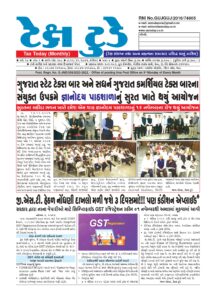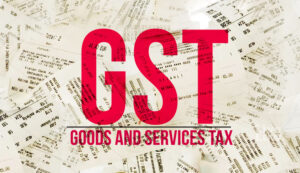GST WEEKLY UPDATE : 23/2023-24 (03.09.2023) By CA Vipul Khandhar

-By CA Vipul Khandhar
- Introducing Electronic Credit Reversal and Reclaimed statement (31/08/2023):
“Vide Notification No. 14/2022 – Central Tax dated 05th July, 2022 (read with circular 170/02/2022-GST, Dated 6th July,2022), the Government introduced certain changes in Table 4 of Form GSTR-3B so as to enable the taxpayers in reporting correct information regarding ITC availed, ITC reversal, ITC re-claimed and ineligible ITC. The re-claimable ITC earlier reversed in Table 4(B)2 may be subsequently claimed in Table 4(A)5 on fulfilment of necessary conditions. Such reclaimed ITC in Table 4(A)5 also needs to be explicitly reported in Table 4D(1)..
In order to facilitate the taxpayers in correct and accurate reporting of ITC reversal and reclaim thereof and to avoid clerical mistakes, a new ledger namely Electronic Credit and Re-claimed Statement is being introduced on the GST portal. This statement will help the taxpayers in tracking of their ITC that has been reversed in Table 4B(2) and thereafter re-claimed in Table 4D(1) and 4A(5) for each return period, starting from August return period. For a detailed advisory please click here .”
Advisory suggest step to be followed for the proceeding ahead for reporting the ITC Reversal opening balance:
- Taxpayers are permitted to use this facility to report their ITC Reversal Balance that has not been reclaimed.
- The taxpayer is advised to report solely those reclaimable ITC reversal balances that meet the legal criteria for re-claim and have not been previously claimed by the taxpayers.
- Taxpayers may report their opening balance until 30th November After 30th November 2023, the option to report the opening balance will be removed, and it will be assumed that the taxpayer has no ITC Reversal Balance to report.
- Taxpayers may amend their opening balance until 31st December 2023. Any reported balance after this date will be considered final and cannot be further amended.
- After 31st December 2023, the updated value shall be frozen with no further attempts provided to the taxpayers to amend their ITC Reversal Balance and this ITC Reversal value will be sent to the Jurisdictional Tax Officer for review.
- Due diligence should be done while reporting/amending the ITC reversal opening balance, because only 3 time amendment is allowed.
- The opening balance that has been reported or amended by the taxpayers shall be credited to the “Electronic Credit Reversal and Re-claimed Statement”. This statement will be used to validate the taxpayer’s ITC Reclaimed amount in Table 40(5) & 4D(1) of form GSTR-3B.
Condition to be take in to account:
- Determination of opening balance of ITC reversal: The option to report “opening ITC reversal balance” does not specify the tax period that shall be taken into consideration for reporting such ITC reversal amount. The same is open to interpretation of GST law by the taxpayer. It may be noted that there is no time limit specified in GST law for re-claiming the previously claimed and reversed ITC. Hence, the taxpayers may interpret the same to include all ITC previously claimed and reversed in GSTR-3B returns but pending for reclaiming in the GSTR-3B.
- Reporting of credit notes in Table 4 of GSTR-3B: As per the clarification, the warning message will be reflected if the total ITC reclaimed exceed the carried forward reversal balance + ITC reversed in Table 4B(2). However, it may be noted that Table 4B(2) of the GSTR-3B includes all ITC reversal other than those pertaining to Rule 38 (ITC by banking or financial institution), Rule 42 (Proportionate ITC reversal for inputs and Input services), Rule 43 (Capital goods related ITC reversal) and Section 17(5) of CGST Act (Blocked ITC). This includes ITC such as reversal of ITC incorrectly claimed, ITC reversal due to non-payment to vendor within 180 days and any other ITC reversed to be re-claimed in future etc. Further, certain taxpayers tend to report credit notes data also in Table 4B(2). In such scenario, the total ITC reversal as per Table 4B(2) is expected to be higher than the ITC reclaimed in 4D(1). Thus, their will be no warning message even when the total ITC reclaimed by the taxpayer is exceeding the amount eligible for re-claim. Thus, it is necessary that taxpayers stop reporting of credit notes in Table 4B(2) of GSTR-3B and consider their impact in Table 4A(5) itself only i.e., in “All other ITC”.
- Section 16 conditions and contradiction between books and GSTR-3B in method of recording of ITC: As per the earlier advisory of CBIC, the taxpayers are required to report the ITC reversal on account of non-fulfilment of conditions prescribed in Section 16 such as non-receipt of tax paying document, non-receipt of goods and/or services or non-payment of tax by supplier to government in Table 4B(2) of the GSTR-3B. Thus, when the taxpayer claim such ITC in GSTR-3B of subsequent months, it will become a re-claim of credit and consequently required to be reported in Table 4D(1). However, this is contrary to the recording of purchases in the books by certain taxpayers. This is because the taxpayers have inbuilt system restrictions on ITC availment until and unless the Section 16 conditions are satisfied. Thus, when such credit is claimed in the books upon fulfilment of Section 16 conditions, it is recorded as ITC availment and not ITC re-availment. This creates a difference in ITC re-availment numbers between books and GST returns. To avoid this reconciliation difference, taxpayer may reduce in Table 4A(5) of GSTR-3B, the amount of credit pertaining to such invoices wherein Section 16 conditions are not satisfied but ITC is auto-reflected in GSTR-3B basis the GSTR-2B.
- Advisory for applicants where GST Registration application marked for Biometric-based Aadhaar Authentication (28/08/2023):
- Rule 8 of CGST Rules had been amended to provide that those applicants who had opted for authentication of Aadhaar number and identified on the common portal, based on data analysis and risk parameters, shall be placed for biometric-based Aadhaar authentication and taking photograph(s) of the applicant.
- Pilot for implementation of the above change is ready and the functionality is ready for roll out by GSTN portal. This functionality is being launched in Puducherry from 30th August, 2023 in the pilot phase. After submission of application in Form GST REG-01 and before generation of ARN, the applicant will either get the message for visiting GST Suvidha Kendra (GSK) or a link on the declared Mobile and Email ID; as may be applicable at TRN stage, based on identification by common portal so that registration process may be completed.
- Those applicants who get the link on Mobile & Email ID for Aadhaar Authentication, they can proceed for completing their application as per existing implementation.
- However, those applicants who get message for visiting GSK, will be required to visit at the designated GSK as conveyed on Mobile/Email and get biometric authentication for all required persons as per the GST Application Form REG-01. The applicants are requested to visit GSK before the TRN expiry date as detailed in Email for Biometric-based Aadhaar Authentication process. In this case, Application Reference Number (ARN) will be generated only after the completion of Biometric-based Aadhaar Authentication process.
- The days of operation of GSK would be as advised by the administration in your state.
- Important AAR & Judgeents:
(i) AAR On Interest on Delayed Payment against supply of services is includible in supply value:
(Applicant – Ganga STP Project Private Limited)
The Ganga STP Project Private Limited was awarded a water treatment project by the National Mission for Clean Ganga (NMCG) & Kolkata Metropolitan Development Authority (KMDA). Payments for the project are structured in a way that includes interest on 60% of the project’s capital expenditure (Capex) due to delayed payments. The key question raised is whether this interest should attract GST.
The Central GST Act and the West Bengal GST Act largely echo each other on this issue. According to section 15 of the GST Act, the value of the supply should include “interest or late fee or penalty for delayed payment of any consideration for any supply.”
The Applicant’s Argument: The company argued that the interest payments serve to compensate for the loss incurred due to the delayed payment of 60% Capex. They believe this should not be subject to GST as it does not form a part of the value of supply.
Counter Arguments: The project authority, KMDA, contended that the interest payments are a time cost linked to the State Bank of India’s Marginal Cost of Funds-based Lending Rate (SBI MCLR). Therefore, it should be included in the value of supply and should attract GST.
Observations & Findings: The Authority for Advance Ruling (AAR) in West Bengal clarified that as per clause (d) of sub-section (2) of section 15, such interest will be included in the value of supply. This means that it will indeed be taxed.
Disclaimer:
This publication contains information for general guidance only. It is not intended to address the circumstances of any particular individual or entity. Although the best of endeavour has been made to provide the provisions in a simpler and accurate form, there is no substitute to detailed research with regard to the specific situation of a particular individual or entity. We do not accept any responsibility for loss incurred by any person for acting or refraining to act as a result of any matter in this publication.
(The author is well known Chartered Accountant practicing at Ahmedabad)





